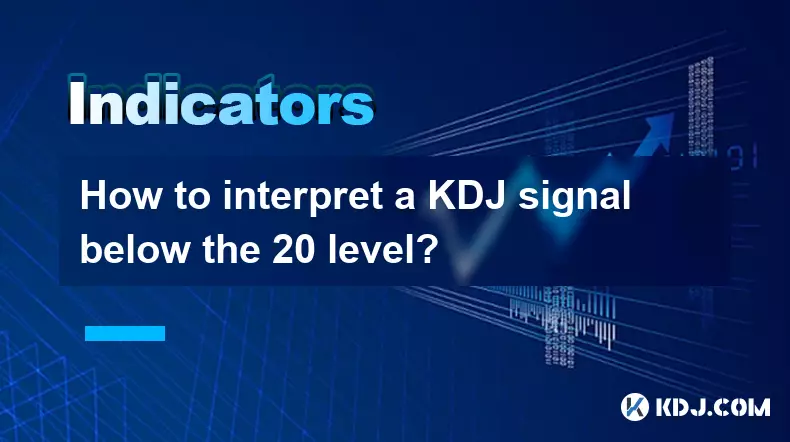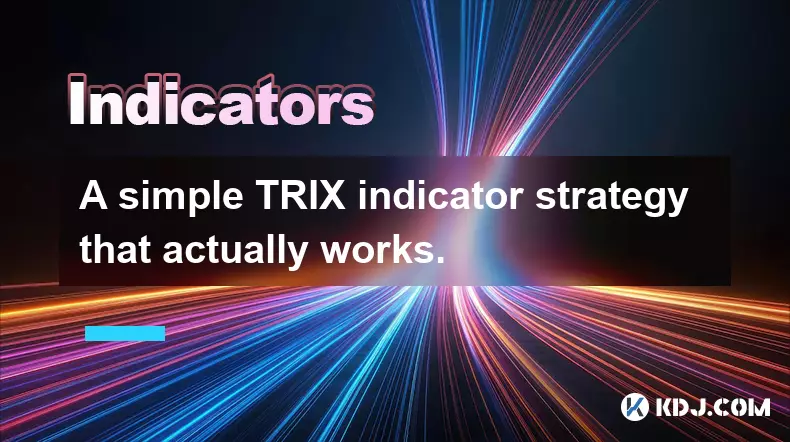-
 bitcoin
bitcoin $102877.190955 USD
1.88% -
 ethereum
ethereum $3430.435064 USD
4.52% -
 tether
tether $0.999264 USD
-0.05% -
 xrp
xrp $2.307310 USD
4.49% -
 bnb
bnb $987.740692 USD
3.82% -
 solana
solana $161.947760 USD
3.97% -
 usd-coin
usd-coin $0.999712 USD
-0.05% -
 tron
tron $0.292810 USD
2.93% -
 dogecoin
dogecoin $0.179738 USD
10.70% -
 cardano
cardano $0.580716 USD
8.75% -
 hyperliquid
hyperliquid $42.463448 USD
8.40% -
 chainlink
chainlink $15.763437 USD
7.05% -
 zcash
zcash $649.595636 USD
17.21% -
 bitcoin-cash
bitcoin-cash $511.610261 USD
7.19% -
 stellar
stellar $0.292537 USD
7.91%
How to interpret a KDJ signal below the 20 level?
A KDJ reading below 20 in crypto trading suggests oversold conditions, potentially signaling a bullish reversal, especially when confirmed by volume and price action.
Nov 06, 2025 at 01:05 pm

Understanding the KDJ Indicator in Cryptocurrency Trading
The KDJ indicator, a derivative of the stochastic oscillator, is widely used in cryptocurrency trading to identify potential reversal points in market trends. It consists of three lines: %K (the fast line), %D (the slow line, which is a moving average of %K), and %J (a measure of the distance between %K and %D). When all three lines fall below the 20 level, it signals that the asset may be oversold.
This condition often suggests that selling pressure has been strong, potentially pushing prices lower than their intrinsic value. Traders interpret this as a possible opportunity for a bullish reversal, especially when supported by other technical or fundamental indicators.
Implications of a Sub-20 KDJ Reading
A reading below 20 on the KDJ indicator typically indicates that the market is in an oversold condition, meaning the asset has experienced prolonged downward momentum.
- In the volatile crypto markets, such extreme readings can precede short-term rebounds, even if the broader downtrend remains intact.
When both %K and %D are below 20 and begin to cross upward, it may signal that buying interest is starting to emerge.
The %J line dropping deep below 20 and then rising rapidly can reflect a sharp correction or a sudden shift in sentiment, common during flash crashes in digital assets.
It’s crucial to assess volume and price action alongside the KDJ; a breakout on high volume from an oversold zone increases the reliability of a reversal signal.
Strategic Responses to Oversold KDJ Signals
Traders may consider positioning for long entries when the KDJ lines rise above 20 after being below it, treating it as a confirmation of momentum shift.
- Setting stop-loss orders just below recent price lows helps manage risk, especially in low-liquidity altcoins where slippage is common.
Combining the KDJ with moving averages or RSI can filter out false signals—when multiple indicators align, confidence in the setup improves.
In ranging markets, sub-20 KDJ levels often act as reliable bounce zones, making them useful for scalping strategies on shorter timeframes like 1-hour or 15-minute charts.
During bear markets, repeated trips below 20 without follow-through rallies suggest persistent weakness, cautioning against aggressive long positions.
Contextual Factors Affecting KDJ Reliability
Market context matters—during major crypto sell-offs triggered by macroeconomic news or exchange failures, oversold conditions can persist longer than expected.
- Low-cap tokens frequently show exaggerated KDJ movements due to thin order books, making oversold signals less trustworthy without volume confirmation.
Divergence analysis enhances interpretation: if prices make new lows but the KDJ fails to reach new lows, it hints at weakening downside momentum.
Timeframe selection influences signal quality—a sub-20 reading on a daily chart carries more weight than one on a 5-minute chart.
Frequently Asked Questions
What does a KDJ crossover below 20 indicate?A bullish crossover (where %K crosses above %D) while both are below 20 suggests potential upward momentum returning. This is viewed as a buy signal by many traders, particularly when accompanied by increasing trading volume.
Can KDJ remain below 20 for extended periods?Yes, especially during strong downtrends or market panics. In such cases, the indicator may stay oversold for days or weeks, indicating sustained selling pressure rather than an imminent reversal.
How should traders confirm a KDJ-based entry signal?Confirmation can come from candlestick patterns (like hammers or bullish engulfing), trendline breaks, or alignment with support levels. Additionally, monitoring Bitcoin’s movement can help, as most altcoins correlate strongly with its price action.
Is the KDJ effective across all cryptocurrencies?Its effectiveness varies. Major coins like Bitcoin and Ethereum tend to produce more reliable signals due to higher liquidity and clearer price trends. For smaller, less liquid tokens, erratic price swings can generate misleading KDJ readings.
Disclaimer:info@kdj.com
The information provided is not trading advice. kdj.com does not assume any responsibility for any investments made based on the information provided in this article. Cryptocurrencies are highly volatile and it is highly recommended that you invest with caution after thorough research!
If you believe that the content used on this website infringes your copyright, please contact us immediately (info@kdj.com) and we will delete it promptly.
- Ripple (XRP) in 2026: Hold or Fold? A Look at XRP's Future and Emerging DeFi Alternatives
- 2025-11-08 18:35:01
- Zcash ZEC Coin Price Explosion: From Privacy Niche to Center Stage
- 2025-11-08 18:55:01
- Berachain Price Prediction: Navigating the Honeycomb Hype in Crypto
- 2025-11-08 18:55:01
- Arthur Hayes, Gold, and Bitcoin: A Modern Monetary Trinity?
- 2025-11-08 19:15:01
- Shiba Inu's Next Move: Navigating a Shifting Market
- 2025-11-08 19:20:01
- Pakistan's Crypto Crossroads: Balancing Opportunity with Asset-Backed Realities
- 2025-11-08 19:20:01
Related knowledge

How do professional traders use the TRIX indicator?
Nov 06,2025 at 04:40pm
Understanding the TRIX Indicator in Crypto TradingThe TRIX (Triple Exponential Average) indicator is a momentum oscillator used by professional trader...

Can I use the TRIX indicator on my mobile trading app?
Nov 07,2025 at 07:40pm
The TRIX indicator, a momentum oscillator designed to filter out short-term fluctuations and highlight long-term trends, has become increasingly popul...

How to code a simple TRIX indicator script in Pine Script?
Nov 07,2025 at 06:20am
How to Code a Simple TRIX Indicator in Pine Script The TRIX (Triple Exponential Moving Average) indicator is widely used in cryptocurrency trading to ...

A simple TRIX indicator strategy that actually works.
Nov 08,2025 at 05:39pm
Understanding the TRIX Indicator in Crypto Trading1. The TRIX (Triple Exponential Average) indicator is a momentum oscillator designed to filter out s...

How to trade TRIX indicator signals on the 1-hour chart?
Nov 07,2025 at 05:39am
Bitcoin's Role in Decentralized Finance1. Bitcoin remains the cornerstone of decentralized finance, serving as a benchmark for value and security acro...

Can the TRIX indicator be used for long-term investing?
Nov 06,2025 at 02:19pm
Understanding the TRIX Indicator in Cryptocurrency Markets1. The TRIX (Triple Exponential Average) indicator is a momentum oscillator designed to filt...

How do professional traders use the TRIX indicator?
Nov 06,2025 at 04:40pm
Understanding the TRIX Indicator in Crypto TradingThe TRIX (Triple Exponential Average) indicator is a momentum oscillator used by professional trader...

Can I use the TRIX indicator on my mobile trading app?
Nov 07,2025 at 07:40pm
The TRIX indicator, a momentum oscillator designed to filter out short-term fluctuations and highlight long-term trends, has become increasingly popul...

How to code a simple TRIX indicator script in Pine Script?
Nov 07,2025 at 06:20am
How to Code a Simple TRIX Indicator in Pine Script The TRIX (Triple Exponential Moving Average) indicator is widely used in cryptocurrency trading to ...

A simple TRIX indicator strategy that actually works.
Nov 08,2025 at 05:39pm
Understanding the TRIX Indicator in Crypto Trading1. The TRIX (Triple Exponential Average) indicator is a momentum oscillator designed to filter out s...

How to trade TRIX indicator signals on the 1-hour chart?
Nov 07,2025 at 05:39am
Bitcoin's Role in Decentralized Finance1. Bitcoin remains the cornerstone of decentralized finance, serving as a benchmark for value and security acro...

Can the TRIX indicator be used for long-term investing?
Nov 06,2025 at 02:19pm
Understanding the TRIX Indicator in Cryptocurrency Markets1. The TRIX (Triple Exponential Average) indicator is a momentum oscillator designed to filt...
See all articles





















![The Graph Price Prediction [GRT Crypto Price News Today] The Graph Price Prediction [GRT Crypto Price News Today]](/uploads/2025/11/07/cryptocurrencies-news/videos/690d4df44fe69_image_500_375.webp)



















































